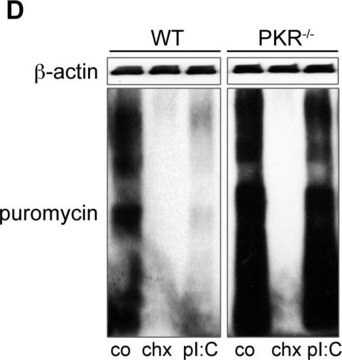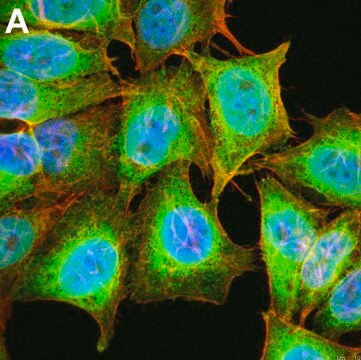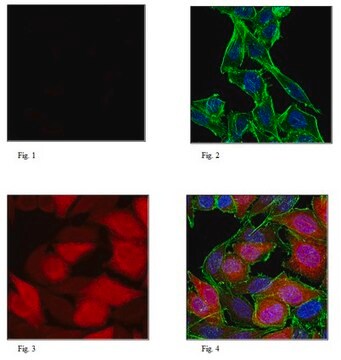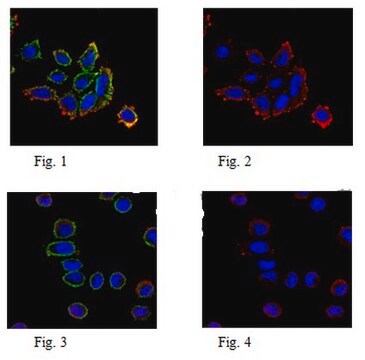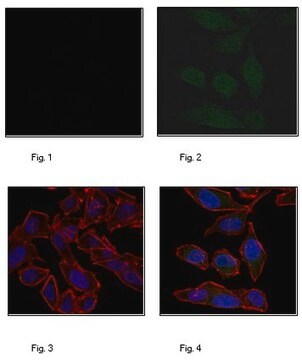MABE343-AF488
Anti-Puromycin, clone 12D10, Alexa Fluor™ 488 Conjugate Antibody
clone 12D10, 0.5 mg/mL, from mouse
Synonym(s):
Alexa Fluor 488 antibody
Sign Into View Organizational & Contract Pricing
All Photos(3)
About This Item
UNSPSC Code:
12352203
eCl@ss:
32160702
NACRES:
NA.41
conjugate:
ALEXA FLUOR™ 488
application:
ICC
clone:
12D10, monoclonal
species reactivity:
human
citations:
18
technique(s):
immunocytochemistry: suitable
Recommended Products
biological source
mouse
Quality Level
conjugate
ALEXA FLUOR™ 488
antibody form
purified antibody
antibody product type
primary antibodies
clone
12D10, monoclonal
species reactivity
human
concentration
0.5 mg/mL
technique(s)
immunocytochemistry: suitable
shipped in
wet ice
target post-translational modification
unmodified
General description
Puromycin is an aminonucleoside antibiotic, derived from the Streptomyces alboniger bacterium, that functions as a protein synthesis inhibitor that blocks translation through premature chain termination in the ribosome. Monoclonal antibodies to puromycin may be used with standard immunochemical methods to directly monitor translation, a method known as surface sensing of translation (SUnSET). Part of the molecule resembles the 3′ end of the aminoacylated tRNA, making it useful for protein translation analysis. Puromycin induces DNA fragmentation in thymocytes and in human HL-60 leukemia cells.
This product is a conjugated version of Cat. No. MABE343.
This product is a conjugated version of Cat. No. MABE343.
Specificity
Demonstrated to react with Human test sample, preincubated with Puromycin. Predicted to react with all species when test sample is incubated with Puromycin.
This antibody detects Puromycin-incorporated neosynthesized proteins.
Immunogen
Puromycin-incorporated neosynthesized proteins at multiple molecular weights
Application
Research Category
Epigenetics & Nuclear Function
Epigenetics & Nuclear Function
Research Sub Category
Cell Cycle, DNA Replication & Repair
Cell Cycle, DNA Replication & Repair
This Anti-Puromycin, clone 12D10 is validated for use in Immunocytochemistry for the detection of Puromycin.
Quality
Evaluated by Immunocytochemistry in untreated and Puromycin treated HeLa cells.
Immunocytochemistry Analysis: A 1:2,500 dilution of this antibody detected Puromycin-incorporated neosynthesized proteins in HeLa cells treated with Puromycin only.
Alexa Fluor™ is a registered trademark of Life Technologies.
Immunocytochemistry Analysis: A 1:2,500 dilution of this antibody detected Puromycin-incorporated neosynthesized proteins in HeLa cells treated with Puromycin only.
Alexa Fluor™ is a registered trademark of Life Technologies.
Target description
Refer to Cat. No. MABE343 for observed molecular weight information.
Physical form
Protein G Purified
Purified rat monoclonal conjugate in buffer containing PBS and 15 mg/ml BSA with 0.1% Sodium Azide.
Storage and Stability
Stable for 1 year at 2-8°C from date of receipt.
Legal Information
ALEXA FLUOR is a trademark of Life Technologies
Disclaimer
Unless otherwise stated in our catalog or other company documentation accompanying the product(s), our products are intended for research use only and are not to be used for any other purpose, which includes but is not limited to, unauthorized commercial uses, in vitro diagnostic uses, ex vivo or in vivo therapeutic uses or any type of consumption or application to humans or animals.
Not finding the right product?
Try our Product Selector Tool.
Storage Class Code
12 - Non Combustible Liquids
WGK
WGK 2
Flash Point(F)
Not applicable
Flash Point(C)
Not applicable
Certificates of Analysis (COA)
Search for Certificates of Analysis (COA) by entering the products Lot/Batch Number. Lot and Batch Numbers can be found on a product’s label following the words ‘Lot’ or ‘Batch’.
Already Own This Product?
Find documentation for the products that you have recently purchased in the Document Library.
Sara Ricciardi et al.
Cell metabolism, 28(6), 895-906 (2018-09-11)
Naive T cells respond to T cell receptor (TCR) activation by leaving quiescence, remodeling metabolism, initiating expansion, and differentiating toward effector T cells. The molecular mechanisms coordinating the naive to effector transition are central to the functioning of the immune system, but remain
Hovy Ho-Wai Wong et al.
Neuron, 95(4), 852-868 (2017-08-07)
Nascent proteins can be positioned rapidly at precise subcellular locations by local protein synthesis (LPS) to facilitate localized growth responses. Axon arbor architecture, a major determinant of synaptic connectivity, is shaped by localized growth responses, but it is unknown whether
Sameer Aryal et al.
Proceedings of the National Academy of Sciences of the United States of America, 118(18) (2021-04-29)
Loss of the fragile X mental retardation protein (FMRP) causes fragile X syndrome (FXS). FMRP is widely thought to repress protein synthesis, but its translational targets and modes of control remain in dispute. We previously showed that genetic removal of
Nisha Raj et al.
Cell reports, 35(2), 108991-108991 (2021-04-15)
Transcriptional silencing of the FMR1 gene in fragile X syndrome (FXS) leads to the loss of the RNA-binding protein FMRP. In addition to regulating mRNA translation and protein synthesis, emerging evidence suggests that FMRP acts to coordinate proliferation and differentiation
Jone López-Erauskin et al.
Neuron, 100(4), 816-830 (2018-10-23)
Through the generation of humanized FUS mice expressing full-length human FUS, we identify that when expressed at near endogenous murine FUS levels, both wild-type and ALS-causing and frontotemporal dementia (FTD)-causing mutations complement the essential function(s) of murine FUS. Replacement of
Our team of scientists has experience in all areas of research including Life Science, Material Science, Chemical Synthesis, Chromatography, Analytical and many others.
Contact Technical Service